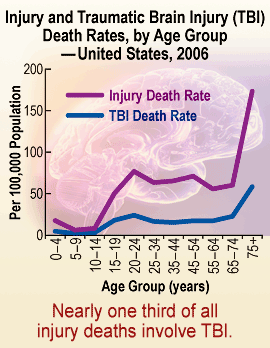Traumatic Brain Injury in the US
 Always wear your seatbelt and remove tripping hazards in the home. Prevention and appropriate response to TBI can help save lives.
Always wear your seatbelt and remove tripping hazards in the home. Prevention and appropriate response to TBI can help save lives.
 Traumatic brain injury (TBI) is a serious public health issue for Americans.
Traumatic brain injury (TBI) is a serious public health issue for Americans.
Each year, TBI contributes to a substantial number of deaths and cases of permanent disability. A TBI is caused by a bump, blow or jolt to the head or a penetrating head injury that disrupts the normal function of the brain. The severity of a TBI may range from "mild" to "severe".
An estimated 1.7 million TBI-related deaths, hospitalizations, and emergency department visits occur in the U.S. each year. Nearly 80% of these individuals are treated and released from an emergency department. TBI is a contributing factor to a third (30.5%) of all injury-related deaths in the United States, or about 52,000 deaths annually.1
Data are critical to understanding the impact of this important public health problem. This information can help inform TBI prevention strategies, identify research and education priorities, and support the need for services among those living with a TBI.
There are many ways to reduce the chances of a TBI, including:
- Wearing a seat belt every time you drive or ride in a motor vehicle.
- Never driving while under the influence of alcohol or drugs.
- Wearing a helmet and making sure your children wear helmets.
- Making living areas safer for seniors and children.
TBI rates vary by age and by sex. Children aged 0 to 4 years, older adolescents aged 15 to 19 years, and adults aged 65 years and older are most likely to sustain a TBI. Almost half a million or 473,947 emergency department visits for TBI are made annually by children aged 0 to 14 years. The rate of Emergency department visits from 1995-2001 period to 2002-2006 period for ages 0-14 increased 6.8 % in the US. Adults aged 75 years and older have the highest rates of TBI-related hospitalization and death. The rate of Emergency department visits from 1995-2001 period to 2002-2006 period for ages 0-14 increased 6.8 % in the US. In every age group, TBI rates are higher for males than for females. More specifically, males aged 0 to 4 years have the highest rates of TBI-related emergency department visits, hospitalizations, and deaths combined.
TBI injuries have many external causes. Falls are the leading cause of TBI. In particularly, falls result in 523,043 TBI-related emergency department visits and 62,334 hospitalizations. TBI rates are highest for children aged 0 to 4 years and for adults aged 75 years and older.
Motor vehicle–traffic injury is the leading cause of TBI-related death. Motor vehicle–traffic injury rates are highest for adults aged 20 to 24 years.
 Additionally, there was an increase in TBI-related emergency department visits (14.4%) and hospitalizations (19.5%) from 2002 to 2006. Also, there was a 62% increase in fall-related TBI seen in emergency departments among children aged 14 years and younger from 2002 to 2006. There was an increase in fall-related TBI among adults aged 65 and older; 46% increase in emergency department visits, 34% increase in hospitalizations, and 27% increase in TBI-related deaths from 2002 to 2006.
Additionally, there was an increase in TBI-related emergency department visits (14.4%) and hospitalizations (19.5%) from 2002 to 2006. Also, there was a 62% increase in fall-related TBI seen in emergency departments among children aged 14 years and younger from 2002 to 2006. There was an increase in fall-related TBI among adults aged 65 and older; 46% increase in emergency department visits, 34% increase in hospitalizations, and 27% increase in TBI-related deaths from 2002 to 2006.
Direct medical costs and indirect costs of TBI, such as lost productivity, totaled an estimated $60 billion in the United States in 2000.2
This estimate is larger than what has been reported in previous reports, including TBI in the United States: A Report to Congress, published by CDC in 2003 and the previous edition of Traumatic Brain Injury in the United States: Emergency Department Visits, Hospitalizations and Deaths, published by CDC in 2004 and revised in 2006. The findings show the importance of including ED visits because of the large number of TBIs seen only in that setting, especially among children. Although this report provides data on a wide range of TBIs occurring in the U.S., it still does not capture all of them. Many people recover from their injuries, but each year an estimated 124,626 Americans sustain a TBI resulting in permanent disability.
 Thus, TBI prevention, improved acute care and rehabilitation to reduce the likelihood of TBI-related disability, and also increased access to services for those who do not fully recover are critical to improving quality of life of persons following TBI.
Thus, TBI prevention, improved acute care and rehabilitation to reduce the likelihood of TBI-related disability, and also increased access to services for those who do not fully recover are critical to improving quality of life of persons following TBI.
Note: CDC analyzed existing national data sets for its report, Traumatic Brain Injury in the United States: Emergency Department Visits, Hospitalizations and Deaths 2002–2006. CDC's National Center for Injury Prevention and Control funds 30 states to conduct TBI surveillance through the CORE State Injury Program. TBI-related death and hospitalization data submitted by participating CORE states are published in CDC's State Injury Indicators Report.
1Faul M, Xu L, Wald MM, Coronado VG. Traumatic Brain Injury in the United States: Emergency Department Visits, Hospitalizations and Deaths 2002–2006. Atlanta (GA): Centers for Disease Control and Prevention, National Center for Injury Prevention and Control; 2010
2 Finkelstein E, Corso P, Miller T and Associates. The Incidence and Economic Burden of Injuries in the United States. New York (NY): Oxford University Press; 2006.
Data Sources
- CDC. Ambulatory Health Care Data.
- CDC. Mortality data, multiple cause-of-death public-use data files, 2006 data.
- CDC. National Hospital Discharge Survey.
- CDC. Traumatic Brain Injury in the United States: Emergency Department Visits, Hospitalizations, and Deaths, 2002-2006. Available as [PDF - 2MB] or [Word - 482K].
- CDC. WISQARS injury mortality reports, 1999-2006.
More Information
![]() facebook.com/cdcheadsup
facebook.com/cdcheadsup
Share your stories with other brain injury survivors, family members and caregivers.
![]() twitter.com/CDCInjury
twitter.com/CDCInjury
On January 27, 2011, CDC hosted the first Live Chat on Twitter about concussion in sports with a panel of professional athletes and experts! (#CDCHeadsUp )
![]() Traumatic Brain Injury Audio Podcasts
Traumatic Brain Injury Audio Podcasts
Learn more about TBI and concussion from these CDC Injury Center audio podcasts.
Get More Information on traumatic brain injury
Order Free Copies of CDC's "Heads Up" Educational Materials
- Order Form for Sports
- Order Form for Health Care Providers
- For Bulk Orders, contact CDC-INFO (include subject heading: "Concussion in Sports")
Download CDC's "Heads Up" Concussion Educational materials, including fact sheets, posters, stickers, etc...
- "Heads Up" for Youth Sports coaches, administrators, and parents
- "Heads Up" for High School coaches, athletic directors, athletic trainers, and parents
- "Heads Up" for school nurses, parents, teachers, counselors, and other school professionals
- "Heads Up" for health care professionals
CDC works 24/7 saving lives and protecting people from health threats to have a more secure nation. A US federal agency, CDC helps make the healthy choice the easy choice by putting science and prevention into action. CDC works to help people live longer, healthier and more productive lives.
Get email updates
To receive email updates about this page, enter your email address:
Contact Us:
- Centers for Disease Control and Prevention
1600 Clifton Rd
Atlanta, GA 30333 - 800-CDC-INFO
(800-232-4636)
TTY: (888) 232-6348 - Contact CDC-INFO



